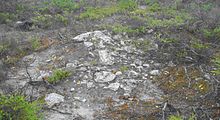Ring of Stones
On 3 November 1930 Burt wrote to the Commissioner of the Western Australia Police to report his discovery of the Ring of Stones in 1875: I was attached to the Admiralty Marine Survey as Draftsman under Capt.
Burt, however, believed the Circle of Stones may have marked the location of a 'Treasure Trove', the specie from the Vergulde Draak, and it would seem that this was his reason for informing the Commissioner of Police.
However, the discovery by two boys, Fred and Alister Edwards, of 40 coins dating from 1618 to 1655, including Spanish reales, in sandhills north of Seabird early in 1931,[4] triggered a frenzy of speculation, mostly relating to the wreck of the Vergulde Draak, and its treasure.
[5] Loxton noted that the 'Sand Drift Hills' as he called the dunes, "increase in size so quickly I would think it quite possible that the Spot may have been covered up years ago".
[5] Although King’s letter was mentioned in a report regarding the searches for the Vergulde Draak's treasure in The Mirror the following year,[2] nothing eventuated and it was simply placed on file.
In March 1933 Constable Loxton filed another report indicating a Mr Stokes, at that time ill in hospital, claimed he had been with Burt and Ogbourne when they found the Ring of Stones in 1875.
[5] There matters rested until a well-known author and bushman J. E. Hammond, a friend of Alfred Burt’s, decided that he would endeavour to find the Ring of Stones.
It appears that some time in 1937 Hammond spent a fortnight searching, burning "several hundred acres of scrub" in the process, without success, before concluding that the Ring had been covered by drifting sand.
[6] Speculation about the treasure from the Vergulde Draak then re-intensified in March 1938 when it was reported that more old coins had been found by children from the Baramba Assisted School, in the same locality as the Edwards find.
The oldest stock route ran through better watered country about 15 km (9.3 mi) inland, and Aboriginal stone arrangements in southern WA are rare.
Relying primarily on reports published in newspaper and information in Malcolm Uren's book, Sailormen’s Ghosts,[6] Gerritsen, Sheppard and others undertook an initial expedition to relocate the Ring of Stone in April 2004.
The area targeted was based on a map published in The Mirror in 1933, the path Burt took in 1875 and the limited positional information provided by Hayes and Penney.
However, owing to the scrubby nature of the terrain, much of which had been burnt in a bushfire in the preceding year or two, staking of the vehicles' tyres considerably hampered progress.
Before the day was out the expedition was forced to retire to the small coastal town of Leeman with every tyre, including spares, staked and in a varying degree of deflation.
He was about to embark on another expedition in October 2008 when Sheppard was able to source Burt’s original letter, mud-map and relevant reports from police files archived in the State Records Office of Western Australia.
Upon his return to Perth he informed Sheppard, who visited the site a few days later and confirmed that the location seemed to be correct and that the pile of stones did appear to resemble a grave.
[10] However, the remains of what appeared to be a man-made stone wall, overlooking a shallow valley, was located in proximity to the Eneabba West site by Gerritsen on 17 June 2009.
Despite close examination, test pitting and metal detection of the surrounds on two occasions in 2009, no sign of any human occupation or presence could be found[clarification needed].
Possible explanations for this structure that are under consideration are: that is an Aboriginal stone arrangement, or that it was constructed by survivors from the Vergulde Draeck, runaway convicts, drovers or recreational campers, or by those engaged in military exercises in the area.
A 6.4 km2 search area was delineated, the parameters of which were based on a reconstruction of the journey Hayes and Penney undertook, the locational details contained their account, and the uncertainties inherent in this.
Since the beginning of July 2010 other search strategies have been employed based on alternative hypotheses on the location of the Ring of Stones and reconstructions of the journey by Hayes and Penney.



